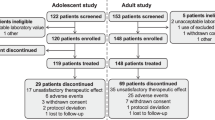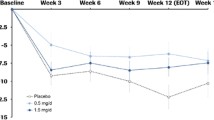Abstract
Glutamatergic dysfunction is implicated in the pathophysiology of fragile X syndrome (FXS). The purpose of this pilot study was to examine the effectiveness and tolerability of memantine for a number of target symptoms associated with FXS. Medical records describing open-label treatment with memantine in 6 patients with FXS and a comorbid diagnosis of PDD were reviewed. Six patients received memantine over a mean 34.7 weeks of treatment. Four of 6 (67%) patients showed global clinical benefit on ratings with the CGI-I. Symptom specific rating scales, however, showed no statistically significant improvement. Two patient developed treatment-limiting irritability on memantine. Memantine was modestly effective in several patients with FXS. Further systematic study is warranted.



Similar content being viewed by others
References
Aman, M. G., Singh, N. N., Stewart, A. W., & Field, C. J. (1985). The aberrant behavior checklist: A behavior rating scale for the assessment of treatment effects. American Journal of Mental Deficiency, 5, 485–491.
American Psychiatric Association. (2000). Diagnostic and statistical manual of mental disorders (text revision) (4th ed.). Washington, D.C.: American Psychiatric Association.
Bailey, D. B., Jr., Hatton, D. D., Skinner, M., & Mesibov, G. (2001). Autistic behavior, FMR1 protein, and developmental trajectories in young males with fragile X syndrome. Journal of Autism and Developmental Disorders, 31(2), 165–174.
Bassell, G. J., & Gross, C. (2008). Reducing glutamate signaling pays off in fragile X. Nature Medicine, 14(3), 249–250.
Bear, M. F. (2005). Therapeutic implications of the mGluR theory of fragile X mental retardation. Genes, Brain, and Behavior, 4(6), 393–398.
Bear, M. F., Dolen, G., Osterweil, E., & Nagarajan, N. (2008). Fragile X: Translation in action. Neuropsychopharmacology, 33(1), 84–87.
Bear, M. F., Huber, K. M., & Warren, S. T. (2004). The mGluR theory of fragile X mental retardation. Trends in Neurosciences, 27(7), 370–377.
Berry-Kravis, E., Hessl, D., Coffey, S., Hervey, C., Schneider, A., Yuhas, J., et al. (2009). A pilot open label, single dose trial of fenobam in adults with fragile X syndrome. Journal of Medical Genetics, 46(4), 266–271.
Berry-Kravis, E., Krause, S. E., Block, S. S., Guter, S., Wuu, J., Leurgans, S., et al. (2006). Effect of CX516, an AMPA-modulating compound, on cognition and behavior in fragile X syndrome: A controlled trial. Journal of Child and Adolescent Psychopharmacology, 16(5), 525–540.
Berry-Kravis, E., & Potanos, K. (2004). Psychopharmacology in fragile X syndrome—present and future. Mental Retardation and Developmental Disabilities Research Reviews, 10(1), 42–48.
Chez, M. G., Aimonovitch, M., Buchanan, T., Mrazek, S., & Tremb, R. J. (2004). Treating autistic spectrum disorders in children: Utility of the cholinesterase inhibitor rivastigmine tartrate. Journal of Child Neurology, 19(3), 165–169.
Chez, M. G., Burton, Q., Dowling, T., Chang, M., Khanna, P., & Kramer, C. (2007). Memantine as adjunctive therapy in children diagnosed with autistic spectrum disorders: An observation of initial clinical response and maintenance tolerability. Journal of Child Neurology, 22(5), 574–579.
Clifford, S., Dissanayake, C., Bui, Q. M., Huggins, R., Taylor, A. K., & Loesch, D. Z. (2007). Autism spectrum phenotype in males and females with fragile X full mutation and premutation. Journal of Autism and Developmental Disorders, 37(4), 738–747.
Constantino, J. N., Davis, S. A., Todd, R. D., Schindler, M. K., Gross, M. M., Brophy, S. L., et al. (2003). Validation of a brief quantitative measure of autistic traits: Comparison of the social responsiveness scale with the autism diagnostic interview-revised. Journal of Autism and Developmental Disorders, 33(4), 427–433.
Dolen, G., & Bear, M. F. (2005). Courting a cure for fragile X. Neuron, 45(5), 642–644.
Dolen, G., & Bear, M. F. (2008). Role for metabotropic glutamate receptor 5 (mGluR5) in the pathogenesis of fragile X syndrome. Journal of Physiology, 586(6), 1503–1508.
DuPaul, G., Power, T., Anastopaulus, A., & Reid, R. (1998). ADHD rating scale IV: Checklists, norms, and clinical interpretation. New York: Guilford.
Erickson, C. A., & Chambers, J. E. (2006). Memantine for disruptive behavior in autistic disorder. Journal of Clinical Psychiatry, 67(6), 1000.
Erickson, C. A., Posey, D. J., Stigler, K. A., Mullett, J., Katschke, A. R., & McDougle, C. J. (2007). A retrospective study of memantine in children and adolescents with pervasive developmental disorders. Psychopharmacology (Berl), 191(1), 141–147.
Evans, S. M., Levin, F. R., Brooks, D. J., & Garawi, F. (2007). A pilot double-blind treatment trial of memantine for alcohol dependence. Alcoholism, Clinical and Experimental Research, 31(5), 775–782.
Findling, R. L., McNamara, N. K., Stansbrey, R. J., Maxhimer, R., Periclou, A., Mann, A., et al. (2007). A pilot evaluation of the safety, tolerability, pharmacokinetics, and effectiveness of memantine in pediatric patients with attention-deficit/hyperactivity disorder combined type. Journal of Child and Adolescent Psychopharmacology, 17(1), 19–33.
Florencia, G., Irene, S., & Veronica, F. (2006). Fragile-X mental retardation: Molecular diagnosis in Argentine patients. Journal of Biochemistry and Molecular Biology, 39(6), 766–773.
Gerard, B., Le Heuzey, M. F., Brunie, G., Lewine, P., Saiag, M. C., Cacheux, V., et al. (1997). Systematic screening for fragile X syndrome in a cohort of 574 mentally retarded children. Annales de Genetique, 40(3), 139–144.
Guy, W. (1976). ECDEU assessment manual for psychopharmacology, Publication No. 76–338. Rockville, MD: U.S. DHEW, NIMH.
Huber, K. M., Gallagher, S. M., Warren, S. T., & Bear, M. F. (2002). Altered synaptic plasticity in a mouse model of fragile X mental retardation. Proceedings of the National Academy of Sciences of the United States of America, 99(11), 7746–7750.
Lieberman, J. A., Papadakis, K., Csernansky, J., Litman, R., Volavka, J., Jia, X. D., et al. (2008). A randomized, placebo-controlled study of memantine as adjunctive treatment in patients with schizophrenia. Neuropsychopharmacology, 34(5), 1322–1329.
Lord, C., Rutter, M., Goode, S., Heemsbergen, J., Jordan, H., Mawhood, L., et al. (1989). Autism diagnostic observation schedule: A standardized observation of communicative and social behavior. Journal of Autism and Developmental Disorders, 19(2), 185–212.
Lord, C., Rutter, M., & Le Couteur, A. (1994). Autism diagnostic interview-revised: A revised version of a diagnostic interview for caregivers of individuals with possible pervasive developmental disorders. Journal of Autism and Developmental Disorders, 24(5), 659–685.
Mobius, H. J., Stoffler, A., & Graham, S. M. (2004). Memantine hydrochloride: Pharmacological and clinical profile. Drugs Today (Barcelona), 40(8), 685–695.
Muhonen, L. H., Lonnqvist, J., Juva, K., & Alho, H. (2008). Double-blind, randomized comparison of memantine and escitalopram for the treatment of major depressive disorder comorbid with alcohol dependence. Journal of Clinical Psychiatry, 69(3), 392–399.
Owley, T., Salt, J., Guter, S., Grieve, A., Walton, L., Ayuyao, N., et al. (2006). A prospective, open-label trial of memantine in the treatment of cognitive, behavioral, and memory dysfunction in pervasive developmental disorders. Journal of Child and Adolescent Psychopharmacology, 16(5), 517–524.
Parsons, C. G., & Gilling, K. (2007). Memantine as an example of a fast, voltage-dependent, open channel N-methyl-d-aspartate receptor blocker. Methods in Molecular Biology, 403, 15–36.
Pilpel, Y., Kolleker, A., Berberich, S., Ginger, M., Frick, A., Mientjes, E., et al. (2008). Synaptic ionotropic glutamate receptors and plasticity are developmentally altered in the CA1 field of FMR1 KO mice. The Journal of Physiology, 587(Pt 4), 787–804.
Reisberg, B., Doody, R., Stoffler, A., Schmitt, F., Ferris, S., & Mobius, H. J. (2003). Memantine in moderate-to-severe Alzheimer’s disease. New England Journal of Medicine, 348(14), 1333–1341.
Rogers, S. J., Wehner, D. E., & Hagerman, R. (2001). The behavioral phenotype in fragile X: Symptoms of autism in very young children with fragile X syndrome, idiopathic autism, and other developmental disorders. Journal of Developmental and Behavioral Pediatrics, 22(6), 409–417.
SPSS Inc. (2005). SPSS 13.0 for windows. Chicago, IL: SPSS, Inc.
Tervonen, T. A., Louhivuori, V., Sun, X., Hokkanen, M. E., Kratochwil, C. F., Zebryk, P., et al. (2008). Aberrant differentiation of glutamatergic cells in neocortex of mouse model for fragile X syndrome. Neurobiology of Disease, 33(2), 250–259.
Zarate, C. A., Jr., Singh, J. B., Quiroz, J. A., De Jesus, G., Denicoff, K. K., Luckenbaugh, D. A., et al. (2006). A double-blind, placebo-controlled study of memantine in the treatment of major depression. American Journal of Psychiatry, 163(1), 153–155.
Acknowledgments
This work is supported in part by The Division of Disability & Rehabilitative Services, Indiana Family and Social Services Administration (Drs. Erickson, McDougle); National Institute of Health grant K12 UL1 RR025761 Indiana University Clinical and Translational Sciences Institute Career Development Award (Dr. Erickson); and NIMH grant R01 MH072964 (Dr. McDougle).
Author information
Authors and Affiliations
Corresponding author
Rights and permissions
About this article
Cite this article
Erickson, C.A., Mullett, J.E. & McDougle, C.J. Open-Label Memantine in Fragile X Syndrome. J Autism Dev Disord 39, 1629–1635 (2009). https://doi.org/10.1007/s10803-009-0807-3
Received:
Accepted:
Published:
Issue Date:
DOI: https://doi.org/10.1007/s10803-009-0807-3




